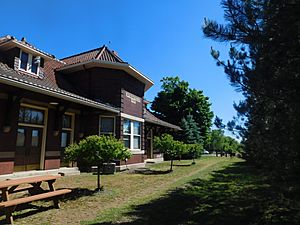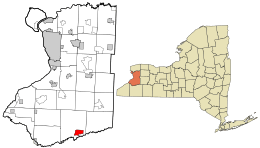Springville, New York facts for kids
Quick facts for kids
Springville
|
|
|---|---|
|
Village
|
|
| Village of Springville | |

The former Springville depot for the Buffalo, Rochester and Pittsburgh Railroad in June 2016.
|
|
| Nickname(s):
Cold Springs |
|

Location in Erie County and the state of New York
|
|
| Country | United States |
| State | New York |
| County | Erie |
| Town | Concord |
| Area | |
| • Total | 3.69 sq mi (9.56 km2) |
| • Land | 3.68 sq mi (9.53 km2) |
| • Water | 0.01 sq mi (0.02 km2) |
| Elevation | 1,329 ft (405 m) |
| Population
(2020)
|
|
| • Total | 4,225 |
| • Density | 1,148.10/sq mi (443.26/km2) |
| Time zone | UTC-5 (Eastern (EST)) |
| • Summer (DST) | UTC-4 (EDT) |
| ZIP code |
14141
|
| Area code(s) | 716 |
| FIPS code | 36-70442 |
| GNIS feature ID | 0966106 |
Springville is a small town, also called a village, located in the southeastern part of Concord in Erie County, New York, United States. It's the main community in the town and an important business area in southern Erie County. In 2020, about 4,225 people lived there. Springville is part of a larger area called the Buffalo–Niagara Falls Metropolitan Statistical Area, which means it's connected to the bigger cities of Buffalo and Niagara Falls.
Before it was called Springville, the village had a different name: "Fiddler's Green." Springville is also famous for being the hometown of Glenn "Pop" Warner, a very important person in the history of American Football.
Contents
History of Springville
Early Settlers and Education
In 1808, a person named Samuel Cochran became the first permanent settler in the area. This land was once known as the Holland Purchase.
Education started early in Springville. The Springville Academy opened in 1830. It was the first high school in Erie County. Later, in 1867, it was renamed Springville Griffith Institute. This new name honored Archibald Griffith, who was a generous donor to the school.
The village of Springville officially became a village in 1834. It was formed from a part of the larger town of Concord. The Dygert Farm, located on Elk Street, was a special place. It hosted the Erie County Fair in 1866 and 1867. This farm was also used as a training spot for the famous athlete Jim Thorpe.
Art and Historic Buildings
The Springville post office has a beautiful mural inside. It's called Fiddler's Green and was painted in 1939 by Victoria Hutson Huntley. This mural was part of a government program. The program hired artists to create art for public buildings across the United States.
Springville is home to several buildings that are listed on the National Register of Historic Places (NRHP). These places are important because they have special historical or architectural value. Some of these include:
- Citizens National Bank
- Buffalo, Rochester and Pittsburgh Railroad Station
- Baptist Church of Springville
- United States Post Office
- Scoby Power Plant and Dam
There are also two historic areas listed on the NRHP: the East Main-Mechanic Streets Historic District and the East Hill Historic District.
Geography and Location
Size and Nearby Areas
Springville covers a total area of about 3.7 square miles (9.56 square kilometers). Most of this area is land, with a very small part being water.
To the south of the village, you'll find Cattaraugus Creek. This creek also marks the border with Cattaraugus County.
Major Roads and Transportation
Several important roads pass through or near Springville. New York State Route 39 (NY 39) is a main road that goes from east to west. When it enters Springville, it becomes Main Street.
U.S. Route 219, also known as the Southern Expressway, runs just west of the village. NY 240 (Vaughn Street) is another important road. It goes from north to south and forms the eastern edge of the village.
Population and People
Population Changes Over Time
The population of Springville has changed over many years. Here's how it has grown and shifted:
| Historical population | |||
|---|---|---|---|
| Census | Pop. | %± | |
| 1870 | 1,006 | — | |
| 1880 | 1,227 | 22.0% | |
| 1890 | 1,883 | 53.5% | |
| 1900 | 1,992 | 5.8% | |
| 1910 | 2,246 | 12.8% | |
| 1920 | 2,331 | 3.8% | |
| 1930 | 2,540 | 9.0% | |
| 1940 | 2,849 | 12.2% | |
| 1950 | 3,322 | 16.6% | |
| 1960 | 3,852 | 16.0% | |
| 1970 | 4,350 | 12.9% | |
| 1980 | 4,285 | −1.5% | |
| 1990 | 4,310 | 0.6% | |
| 2000 | 4,252 | −1.3% | |
| 2010 | 4,296 | 1.0% | |
| 2020 | 4,225 | −1.7% | |
| U.S. Decennial Census | |||
Community Makeup (2000 Census)
Based on the census from 2000, there were 4,252 people living in Springville. These people made up 1,705 households and 1,091 families. The village had about 1,164 people per square mile.
Most of the people living in the village were White (98.28%). A smaller number were African American (0.49%), Native American (0.21%), or Asian (0.40%). About 0.61% of the population identified as Hispanic or Latino.
Households and Families
Out of all the households, 31.4% had children under 18 years old living with them. Nearly half (49.3%) were married couples living together. About 10.3% were households led by a female without a husband present.
Many households (31.5%) were made up of just one person. About 16.3% of households had someone living alone who was 65 years old or older. The average household had 2.40 people, and the average family had 3.01 people.
Age and Income
The population of Springville was spread out by age. About 25.1% were under 18 years old. Around 19.1% were 65 years old or older. The average age in the village was 40 years.
In 2000, the average income for a household in Springville was $38,221. For families, the average income was $49,422. The average income per person in the village was $19,302. About 7.4% of the total population lived below the poverty line.
Notable People from Springville
Many interesting people have connections to Springville. Here are a few:
- Bertrand Chaffee: A businessman and farmer who was also a generous giver. He was the president of the Springville and Sardinia Railroad.
- Joseph Gallup Cochran: A missionary, minister, teacher, and translator in the 1800s.
- Elon Howard Eaton: An expert on birds, who went to school in Springville.
- Ken Knowlton: A pioneer in the field of computer graphics.
- Fletcher Pratt: A well-known author and historian.
- Tom Reynolds: A Republican politician.
- George Schuster: A famous driver in the 1908 New York to Paris Auto Race.
- Bill Simon: A songwriter, jazz critic, and saxophonist.
- Pop Warner: A very influential coach who helped shape American football.
- Jack Yellen: A songwriter who wrote famous songs like "Ain't She Sweet" and "Happy Days Are Here Again".
Arts and Culture in Springville
The Springville Center for the Arts is a lively place for creativity. It's a community center that offers many different art activities. They put on theater shows, display art in galleries, and hold workshops where you can learn new skills. The center used to be in a different building, but it closed in 2007. Now, its new home is the old Baptist Church building. You can find it at the corner of North Buffalo Street and Franklin Street.
Schools in Springville
The main school district serving the area is the Springville-Griffith Institute Central School District.
See also
 In Spanish: Springville (Nueva York) para niños
In Spanish: Springville (Nueva York) para niños


